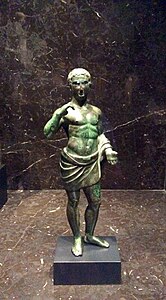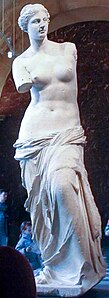The Classical Principle of Contrapposto Was Reintroduced to Western Art by the Sculptor

Contrapposto (Italian pronunciation: [kontrapˈposto]) is an Italian term that ways "counterpoise". It is used in the visual arts to draw a human effigy standing with most of its weight on 1 foot, so that its shoulders and arms twist off-axis from the hips and legs in the axial plane.
First appearing in Aboriginal Greece in the early 5th century BCE, contrapposto is considered a crucial evolution in the history of Ancient Greek art (and, by extension, Western art), as it marks the first time in Western art that the human torso is used to express a psychological disposition. The style was further developed and popularized by sculptors in the Hellenistic and Imperial Roman periods, fell out of use in the Eye Ages, and was later revived during the Renaissance. Michelangelo'south statue of David, i of the most iconic sculptures in the world, is a famous example of contrapposto.
Definition [edit]
Contrapposto was historically an important sculptural development, for its appearance marks the offset time in Western art that the human body is used to express a more relaxed psychological disposition. This gives the figure a more dynamic, or alternatively relaxed appearance. In the frontal plane this besides results in reverse levels of shoulders and hips, for instance: if the right hip is higher than the left; correspondingly the right shoulder will be lower than the left, and vice versa. Information technology can further cover the tension as a effigy changes from resting on a given leg to walking or running upon it (then-chosen ponderation). The leg that carries the weight of the body is known every bit the engaged leg, the relaxed leg is known as the gratuitous leg.[one] Usually, the engaged leg is straight, or very slightly bent, and the free leg is slightly bent.[two] Contrapposto is less emphasized than the more than sinuous S-curve, and creates the illusion of past and future move.[3] A 2019 middle tracking written report by showing that contrapposto acts equally supernormal stimuli and increases perceived attractiveness has provided prove and insight as to why, in creative presentation, goddesses of dazzler and love are oft depicted in contrapposto pose.[4] This later is supported in a neuroimaging study.[five] The term contrapposto tin also be used to refer to multiple figures which are in counter-pose (or opposite pose) to one another.
History [edit]

Kritios Boy. c. 480 BC, was the first known Greek statue to use contrapposto.
Classical [edit]
The get-go known statue to use contrapposto is Kritios Boy, c. 480 BC,[6] then chosen because it was in one case attributed to the sculptor Kritios. It is possible, even probable, that earlier bronze statues had used the technique, but if they did, they have not survived and Kenneth Clark chosen the statue "the first cute nude in art".[7] The statue is a Greek marble original and not a Roman re-create.
Prior to the introduction of contrapposto, the statues that dominated ancient Greece were the archaic kouros (male) and the kore (female). Contrapposto has been used since the dawn of classical western sculpture. According to the canon of the Classical Greek sculptor Polykleitos in the 4th century BC, it is i of the most important characteristics of his figurative works and those of his successors, Lysippos, Skopas, etc. The Polykletian statues (Discophoros ("discus-bearer") and Doryphoros ("spear-bearer"), for example) are idealized able-bodied immature men with the divine sense, and captured in contrapposto. In these works, the pelvis is no longer centric with the vertical statue equally in the archaic style of earlier Greek sculpture before Kritios Male child.
Contrapposto tin can be clearly seen in the Roman copies of the statues of Hermes and Heracles. A famous case is the marble statue of Hermes and the Infant Dionysus in Olympia by Praxiteles. Information technology tin likewise be seen in the Roman copies of Polyclitus's Amazon.
Greek art emphasized humanism along with the human mind and the man body'southward beauty.[8] Greek youths trained and competed in able-bodied contests in the nude. A not bad contribution to the contrapposto pose was the concept of a canon of proportions, in which mathematical properties are used to create proportions.[9]
Renaissance [edit]
Classical contrapposto was revived in Renaissance art past the Italian artists Donatello and Leonardo da Vinci, followed past Michelangelo, Raphael and other artists of the Loftier Renaissance. Ane of the achievements of the Italian Renaissance was the re-discovery of contrapposto.
Mod times [edit]
The technique continues to exist widely employed in sculpture. Mod psychological enquiry confirms the attractiveness of the pose.[ten] [iv] [5]
Examples [edit]
- Examples of contrapposto
-

Etruscan statuette, from Italy, tertiary to 1st century BC, bronze
-

The Venus de Milo depicts an S Bend body shape. Greek, c. 130–100 BC.
-

David, past Michelangelo, 1501–04. The shoulders of the figure are seen to angle in 1 direction, the pelvis in some other.
Come across also [edit]
- Greek statue
- Tribhanga, an Indian stance
References and sources [edit]
- References
- ^ Janson, H.West. (1995) History of Art. 5th edn. Revised and expanded by Anthony F. Janson. London: Thames & Hudson, p. 139. ISBN 0500237018
- ^ Jane Bassett, Peggy Fogelman (1997). "Contrapposto". Looking at European Sculpture: A Guide to Technical Terms. J. Paul Getty Museum. pp. 23–24. ISBN0-892-36-291-Ten.
- ^ "Contrapposto". Grove Encyclopedia Of Materials & Techniques In Fine art: 142–143. October 2008. ISBN 9780195313918.
- ^ a b Pazhoohi, F.; Macedo, M. F.; Doyle, J. F.; Arantes, J. (2019). "Waist-to-Hip Ratio every bit Supernormal Stimuli: Effect of Contrapposto Pose and Viewing Bending". Archives of Sexual Behavior. doi:ten.1007/s10508-019-01486-z.
- ^ a b Pazhoohi, F.; Arantes, J.; Kingstone, A.; Pinal, D. (2020). "Becoming sexy: Contrapposto pose increases attractiveness ratings and modulates observers' brain activity". Biological Psychology. doi:10.1016/j.biopsycho.2020.107842.
- ^ Honour, H. and J. Fleming, (2009) A World History of Fine art. 7th edn. London: Laurence Rex Publishing, p. 122. ISBN 9781856695848
- ^ Clark, Kenneth. (2010) The Nude: A study in ideal form. New edition. London: The Folio Society, pp. 24-25.
- ^ "Greek Humanism". world wide web.webpages.uidaho.edu . Retrieved 2015-11-xix .
- ^ Stanley, Max (2010). "The 'Golden Canon' of book-page construction: proving the proportions geometrically". Journal of Mathematics & The Arts. four no. 3: 137–141.
- ^ Daley, Jason (28 October 2019). "Why Viewers Are Drawn to Renaissance Artists' Go-To Pose". Smithsonian . Retrieved 3 November 2019.
- Sources
- Andrew Stewart, One Hundred Greek Sculptors: Their Careers and Extant Works Polykleitos of Argos, 16.72
- Polykleitos, The J. Paul Getty Museum (archived)
- Gardner, Percy (1911). . Encyclopædia Britannica. Vol. 22 (11th ed.). pp. 22–23.
- Understanding Contrapposto. (website)
Source: https://en.wikipedia.org/wiki/Contrapposto
0 Response to "The Classical Principle of Contrapposto Was Reintroduced to Western Art by the Sculptor"
Publicar un comentario